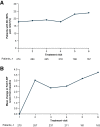Pain Outcomes in Patients with Metastatic Castration-Resistant Prostate Cancer Treated with 223Ra: PARABO, a Prospective, Noninterventional Study
- PMID: 37385670
- PMCID: PMC10478815
- DOI: 10.2967/jnumed.123.265557
Pain Outcomes in Patients with Metastatic Castration-Resistant Prostate Cancer Treated with 223Ra: PARABO, a Prospective, Noninterventional Study
Abstract
223Ra, a targeted α-therapy, is approved for the treatment of patients with metastatic castration-resistant prostate cancer (mCRPC) who have bone metastases. In the phase 3 ALSYMPCA study, 223Ra prolonged survival and improved quality of life versus placebo. Our real-world study, PARABO, investigated pain and bone pain-related quality of life in patients with mCRPC and symptomatic bone metastases receiving 223Ra in clinical practice. Methods: PARABO was a prospective, observational, noninterventional single-arm study conducted in nuclear medicine centers across Germany (NCT02398526). The primary endpoint was a clinically meaningful pain response (≥2-point improvement from baseline for the worst-pain item score in the Brief Pain Inventory-Short Form). Results: The analysis included 354 patients, who received a median of 6 223Ra injections (range, 1-6). Sixty-seven percent (236/354) received 5-6 injections, and 33% (118/354) received 1-4 injections. Of 216 patients with a baseline worst-pain score of more than 1, 59% (128) had a clinically meaningful pain response during treatment. Corresponding rates were 67% (range, 98/146) with 5-6 223Ra injections versus 43% (range, 30/70) with 1-4 injections, 60% (range, 60/100) in patients with no more than 20 lesions versus 59% (range, 65/111) in those with more than 20 lesions, and 65% (range, 69/106) in patients without prior or concomitant opioid use versus 54% (range, 59/110) in those with prior or concomitant opioid use. Mean subscale scores (pain severity and pain interference) on the Brief Pain Inventory-Short Form improved during treatment. Conclusion: 223Ra reduced pain in patients with mCRPC and symptomatic bone metastases, particularly in patients who received 5-6 injections. The extent of metastatic disease did not impact pain response.
Keywords: 223Ra; bone metastases; castration-resistant prostate cancer; pain response; targeted α-therapy.
© 2023 by the Society of Nuclear Medicine and Molecular Imaging.
Figures






References
-
- Broder MS, Gutierrez B, Cherepanov D, Linhares Y. Burden of skeletal-related events in prostate cancer: unmet need in pain improvement. Support Care Cancer. 2015;23:237–247. - PubMed
-
- Wadhwa VK, Weston R, Mistry R, Parr NJ. Long-term changes in bone mineral density and predicted fracture risk in patients receiving androgen-deprivation therapy for prostate cancer, with stratification of treatment based on presenting values. BJU Int. 2009;104:800–805. - PubMed
-
- Iacovelli R, Ciccarese C, Caffo O, et al. . The prognostic value of pain in castration-sensitive prostate cancer. Prostate Cancer Prostatic Dis. 2020;23:654–660. - PubMed
Publication types
MeSH terms
Substances
Associated data
LinkOut - more resources
Full Text Sources
Medical
